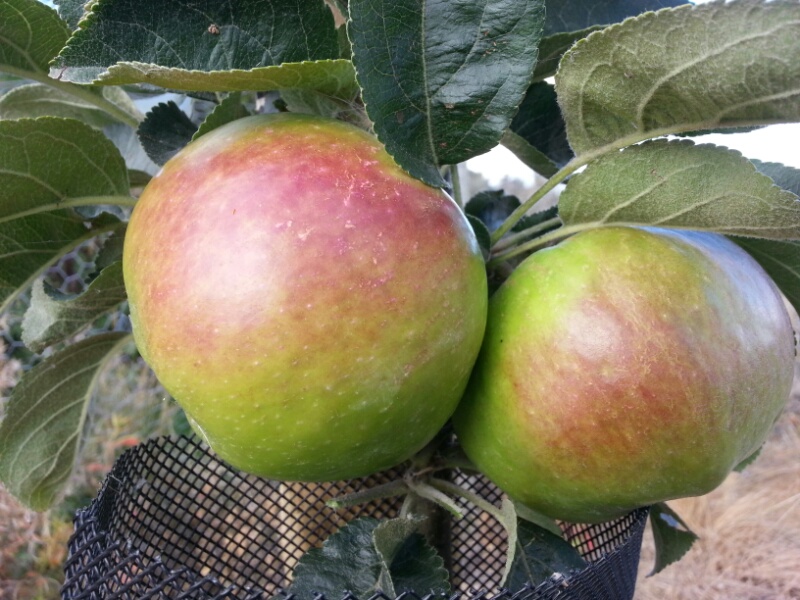After plenty interest in his gooseberry opinions the Governor is back with his selection of the best apple varieties from his orchard at the farm.
Bill says “Apple trees are the most popular garden fruit trees for good reason. Apples are the most versatile fruit as you can eat them fresh, have superb deserts and make your own juice but best of all… home made cider”.
“There are few things more satisfying than picking an apple from your own tree and eating it on a warm day in the late summer”.
 Apple Kings Acre Pippin
Apple Kings Acre Pippin
“This has been a very successful variety in my orchard. The tree has a nice neat habit, the apple stores well and has a good sharp flavour”.
From Herefordshire, 1897, group 4. A healthy, clean tree which crops well. Apples can be eaten off the tree or stored.
 Apple Belle de Boskoop
Apple Belle de Boskoop
“We only graft a few of these but it deserves to be more popular. A superb, eat off the tree variety”.
This variety was discovered in the Netherlands in 1856, group 3. The apple is firm, tart and stores well.
 Apple Cox’s Orange Pippin
Apple Cox’s Orange Pippin
“Actually quite tricky to grow well but the famous apple deserves it’s popularity”.
Introduced 1825, Group 3. Probably the most popular apple to grow at home. Medium sized apples of exceptional flavour which can be eaten from the tree or used in cider making.
 Apple Egremont Russet
Apple Egremont Russet
“This apple will never let you down in Yorkshire. Yes, it has a russet skin but the apple is divine”.
Introduced 1872, group 2. Very popular apple with a distinctive nutty flavour. The tree is self fertile with good frost resistance making it very suitable for northern climates.
 Apple Ellisons Orange
Apple Ellisons Orange
“This variety has all the virtues of Cox but grows better in my opinion. Always a reliable crop in the North”.
From Lincolnshire, 1890, group 4. An offspring of Cox’s Orange Pippin, the apple has a distinct aniseed note. Partially self fertile but will crop better with a suitable pollinator.
 Apple George Cave
Apple George Cave
“An eat off the tree variety with lovely colour and flavour. One of the first of the season”.
Introduced by Mr George Cave of Essex, 1923, group 3. The apples ripen very early, the tree is self fertile offering a reliable crop.
 Apple Golden Spire
Apple Golden Spire
“A most unusual and odd shaped apple. The tree can take a while to establish but it’s worth the wait. The apples are juicy and sweet with a thin shin”.
Introduced 1850 in Lancashire, group 1. An all round apple that is excellent for eating from the tree, cooking, juice or cider.
 Apple Katy
Apple Katy
“Medium sized, sweet apples. This is probably the heaviest cropping tree in the orchard, it never lets you down”.
Introduced 1947 in Sweden, group 3. Excellent frost resistance makes this tree very suitable for northern climates. Very heavy crops of superbly flavoured apples, self fertile.
 Apple Lord Lambourne
Apple Lord Lambourne
“The tree has a neat upright habit, one of the best all round apples”.
Introduced 1905, group 2. The tree has very good disease resistance and some frost resistance. A good multipurpose apple the can be eaten fresh, juiced or cooked.
 Apple Pitmaston Pineapple
Apple Pitmaston Pineapple
“This is an old variety that is new to my orchard but it certainly shows great promise, a lovely, unique flavoured apple”.
Introduced in the 19th century in Worcester, group 4. The tree is very resistant scab and produces apples with a hint of pineapple flavour.
 Apple Pixie
Apple Pixie
“It lives up to it’s name, the tree choose if space is limited”.
Introduced 1947 in England, group 4. A small tree, very suitable for small gardens.


